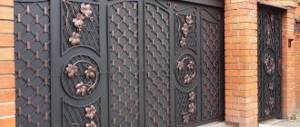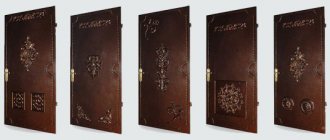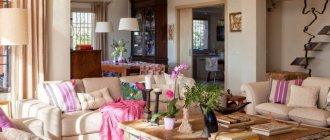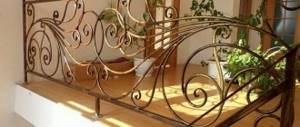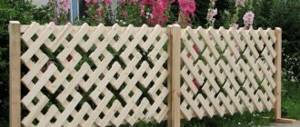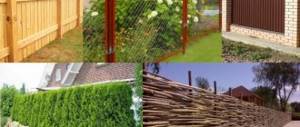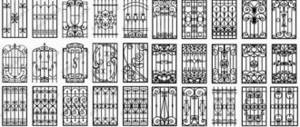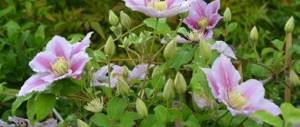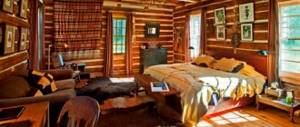Forging is one of the methods of metal processing, the purpose of which is to create products and elements of various configurations. Profiled sheets and forging have functionality, reliability, durability, and practicality. Fence made of corrugated sheets with forging elements will be an excellent decoration for any landscape and will provide security. In this article we will look at fences of this type, their characteristics and other important information.
A photo gallery of various types of fences is presented on a separate page; the catalog is constantly updated. Professional craftsmen and companies of the corresponding profile have the opportunity to send photographs of their forged masterpieces. This type of cooperation will be an excellent promotion option for individual blacksmiths and enterprises of any level.
Those wishing to buy or order a fence are recommended to familiarize themselves with a wide list of companies offering services in the field of metal processing in accordance with hot and cold forging technologies.
Advantages and disadvantages
A fence with forged corrugated sheets has a whole range of advantages. In addition, structures made from these materials have advantages in comparison with classic and wrought iron fences.
Advantages of forged fences with profiled sheets in comparison with classic designs:
- affordable price;
- ease of construction;
- large selection of color solutions for corrugated sheets;
- “blind” design;
- beautiful and functional combination of two materials;
- Possibility of DIY installation.
Flaws:
- strong mechanical stress leads to deformation and the appearance of other defects that spoil the appearance;
- violation of the anti-corrosion layer can lead to rust;
- The material is quite “noisy”.
Advantages of fences with forging and corrugated sheets in comparison with brick-forged structures:
- affordable price;
- ease of construction;
- efficiency of installation.
Flaws:
- subject to mechanical damage;
- corrugated sheeting gets very hot in the sun;
- corrugated sheet is a rather “noisy” material.
Kinds
There are several types of fences made of corrugated sheets with forging. Differences exist in the quantitative ratio of materials.
Made from metal profiles with forged elements
In fences of this type, corrugated sheeting acts as the main material. Forged elements are used to decorate the structure, adding grace and aesthetics. The combination of materials allows you to get a practical and original fence.
Photo “Tekhinkov”
Forged with corrugated sheet
The main material in structures of this type are forged elements, corrugated sheeting acts as a functional addition.
Work by Evgeny Gavrilov
Combined
Designers offer clients several combinations of materials. Next, we will consider combinations of corrugated sheeting and forging with various materials.
1. A fence with corrugated sheets, forging and brick looks aesthetically pleasing, beautiful, reliable and monolithic. The materials combine perfectly with each other. This design clearly demonstrates the artistic taste of the owners.
Work by Maksat Khamzin
2. A fence with forged elements, corrugated board and stone is a reliable and durable structure. Profiled sheets and stone, which have high functional properties, combine perfectly with the graceful forms of forged metal.
This fence from Panov’s forge uses a different sheet material, but the photo gives an idea of the combination.
3. To complement a fence made of corrugated sheets with forged reliability, builders “place” the structure on a strip foundation . This type of base is perfect for heavy products. The foundation protrudes from the ground by a couple of tens of centimeters, which gives the fence not only visible, but also actual reliability.
4. Wood is a functional material, so it goes well with many textures. However, wood does not have a high level of resistance to environmental influences. Wood must be treated with special means. Then the client will receive a strong and durable fence with an interesting design.
5. A gabion is a metal mesh filled with stone or other filler. However, the first option is the most common. The design with corrugated sheeting and forging, complemented by gabions, has an excellent appearance. Fences of this type perfectly protect the house from prying eyes, are easy to install, and look interesting and unusual.
6. The picket fence is galvanized steel cut into strips. A fence made of corrugated sheets with forged parts can be organically supplemented with sections of picket fence, which has the following advantages: a variety of shapes, sizes and colors; strength; reliability; impeccable appearance; ease of installation.
Forged or welded
Welded and forged fences and gates are made from the same material, but use different technologies. In both cases, the elasticity of the metal is used. But it is used in different ways, in different conditions and processes. During the forging process, a metal blank (a rod is usually used for fences) is heated, brought to a certain temperature, and pressed to give it the desired shape. The variety of shapes is great: heated metal becomes many times more plastic, which makes it possible to forge openwork and twisted elements from it.
Having collected a certain number of forged blanks, they are combined into sections, which are then mounted on support pillars. Due to the fact that the work is carried out with softened metal, it is possible to combine the elements of the fence into a single whole almost without seams. Due to this, the forged fence looks very neat.
Classic forging is a long and expensive process, but the fence turns out to be unique
When creating welded fences, the elasticity of the metal is also used, but in a cold state. Twisted and curved elements are also made from rods - the process is called “cold forging”. To obtain welded fence elements of different shapes, there are special devices that allow you to change the shape of the workpieces without heating. But, in a cold state, the ductility of the metal is less, and there are fewer possible variations.
When creating welded fences, the elements are combined by welding. This causes the presence of welded seams. This - the lower artistic value and the presence of seams - is the main difference between welded and forged fences. Otherwise (functionality, durability) they are the same. What else is the difference? In price and production time. Forged fences and gates require much more time to manufacture and cost more, since the process requires special skills and high qualifications. Welded ones are faster and easier to make, and therefore the price is lower.
Forged-welded fences are not so expensive and look interesting
There is also an intermediate type - forged-welded fences. In them, the elements are made by forging, and in sections they are assembled and fastened to each other by welding. Such fences look no less presentable than forged ones, and are cheaper, since the manufacturing process is less labor-intensive.
Related article: Corner sink - saving as much space as possible
More beautiful - lighter
Manufacturers of metal products offer a wide range of profiled sheets of various colors and shades. It is worth noting that light wrought iron fences with corrugated sheets look more interesting than dark ones. This is due to the fact that forging looks especially impressive against a light background. Thus, every line and every curl is clearly visible.
Photo by “Kovali”
Photo: Alexander Valentinovich Yantsen
Photo: Evgeny Gavrilov
Photo: Ilsur Kadyrov
What do customers or those wishing to do need to know?
This section will contain useful and important information for those wishing to purchase/order or install a fence made of corrugated sheets with forging elements. Services for the creation and installation of forged products are offered by companies located in a separate section of our forge catalog. Step-by-step instructions for installing a fence with your own hands will be presented in more detail in the corresponding articles in the “Do It Yourself” section.
Used corrugated sheets
The enterprises produce and sell a wide range of corrugated sheets. There are several criteria for classifying this type of metal product:
1. Thickness may vary and range from 0.4mm. up to 1.2 mm. When erecting a fence, you should choose a thick-walled profiled sheet that can ensure the strength of the structure.
2. Sheet height . The standard indicator does not exceed 2 meters. The maximum value varies depending on the manufacturer, but can reach 12-14 meters.
3. Type of coverage . There are several types of coating: zinc and aluzinc, paint and polymer.
Hot-dip galvanizing is one of the budget coating options and provides good corrosion protection.
The second type of coating - an alloy of aluminum and zinc - has superior protective characteristics to zinc and has a higher level of strength and durability.
The paint layer is applied over the galvanization, thereby creating additional protection and improving the appearance of the canvas. Disadvantage: it scratches easily and is not very resistant to mechanical stress.
Corrugated sheeting with a polymer coating is the most optimal solution when constructing a fence. This coating reliably protects against the influence of weather conditions and mechanical influences, and also improves the aesthetic characteristics of the finished structure. It is worth noting that there are several types of polymer coating: glossy and matte polyester, plastisol, pural, PVDF, Print.
For your information! Companies are constantly improving existing coatings and also offering innovative products. Therefore, we recommend that you inquire about new products that are on sale.
4. Height and type of corrugation . The height is indicated in the marking of the profiled sheet, for example: C8. C – profiled wall sheet with a corrugation height of 8 mm. You can also find the following designations on sale: C10; C13; C15; C18; C20; C21; C25. The higher this indicator, the smaller the working surface of the canvas. Consequently, the greater the number of sheets needed to manufacture the structure.
There are three types of corrugation :
- wave – smooth sinusoid;
- trapezoid;
- cassette – U-shaped rectangular shape.
5. Design. There are profiled sheets in a wide variety of colors on the construction market.
In addition, enterprises offer figured corrugated sheets, the surface of which is covered with drawings. The price for such products is 10-15% higher. Also an interesting solution is corrugated sheeting that imitates other materials: brick, wood, stone. 6. Corrugated sheeting with special properties. Perforated sheets are an excellent sound-proofing material, therefore they are actively used for the construction of fences near highways, railway lines, industrial and other objects with high noise levels. Decorative profiled sheet is intended for the manufacture of country fences.
Recommended sizes
The dimensions of the fence depend on the financial capabilities of the client and on the tasks that the structure must perform.
Height
The height of standard sheets does not exceed 2 meters. The most popular dimensions are 2.0; 1.8 and 1.5 meters. It is worth noting that the client has the opportunity to place an order for corrugated sheets of almost any size.
Span width
The recommended span width is 2-3 meters. Such a design will be characterized by reliability and durability.
General recommendation : the thicker the canvas, the less frequently supports can be installed.
Pillars
For a fence made of corrugated sheets with forging, posts made of any material are suitable. It is important that the material is strong and durable.
Made of metal
Profile pipes, rods or piles will provide excellent support. Metal poles can withstand strong gusts of wind and retain their strength and original appearance for a long time. It is only necessary to periodically update the anti-corrosion protection. For pillars, square pipes 60x60 or round are suitable, the wall thickness is 3 mm.
The length of the support is taken depending on the required height of the fence; a value of 1.0-1.5 meters is also added for penetration into the ground. The posts should be buried in the ground below its freezing point. This parameter varies for different regions; in central Russia it is 1.2 meters. But it’s better to play it safe and make the wells deeper.
Logs for fences are also made from profile pipes, the cross-section of which is 40x20 or 30x20. They are fastened using fasteners or by welding.
Made of brick, stone
Brick is often used as a material for pillars. Advantages: durability, reliability, good combination of textures. Disadvantages: heavy weight, high price.
The construction of brick pillars begins with the installation of metal pipes, around which reinforcement is located and stone laying is carried out. To strengthen the support, concrete is poured inside the pipes. The pipes should go 1.0-1.5 meters into the ground.
Photo “Integral”
Other
Wood is a less optimal option, since the service life of wood is shorter than that of metal. Therefore, this material is suitable for temporary fences.
Asbestos cement pipes are affordable and quite durable. Disadvantages: water should not be allowed to get into the pipes, it is difficult to secure the purlins.
Forged posts are perfect for fences with corrugated sheets. Such supports can have classic and original shapes, are durable and resistant to corrosion, and can withstand significant loads.
Foundation tape
A strip foundation is the best option when installing massive and heavy structures. This type of foundation will require more materials and time spent. But the client is guaranteed to receive a reliable and monolithic fence.
This type of foundation is a continuous strip, the base of which is located at the level of soil freezing (1.0-1.5 m), and the top is located 0.2-0.4 m above the relief mark. Thus, the contractor needs to dig a trench, 0.5-1.5 meters deep and 0.3 m wide. The width of the base should be approximately 5 cm larger than the wall resting on it.
Then you need to fill the bottom with a mixture of gravel and sand and compact it tightly.
The next stage is that reinforcement is laid in the trench, and formwork is secured around the trench. Then concrete is poured into the ditch; after it hardens (about a month), the formwork must be removed.
The foundation is ready for further construction work.
Hand hot or cold forging
Forged products can be produced in accordance with two metal processing technologies. Hot forging involves preheating the workpieces and the actual process of creating patterns and lines. The work is carried out manually by a professional blacksmith.
Implementing projects takes a lot of time and effort from a blacksmith. Therefore, such products are highly expensive. Cold forging is most often performed on automated equipment and without preliminary procedures. Consequently, stamped items are affordable.
Use of ready-made forged elements
The use of stamped elements not only significantly reduces the cost of the finished structure and its production time, but also deprives it of exclusivity. Therefore, the use of ready-made parts has both pros and cons. Each customer, based on his own capabilities and wishes, will be able to decide which option to choose. The following are ready-made forged products for corrugated board fences, which are the most popular:
- the cap for pillars performs both protective and decorative functions;
- finials are used to decorate the tops of the fence, and also perform a protective function;
- Volutes are universal decorative elements;
- poles have a wide range of uses and come in a wide variety of shapes and styles;
- sockets perform a decorative function; can become part of a unique composition.
The full range of ready-made elements is presented on a separate page.
You can purchase stamped parts from many companies that are presented in the corresponding section.
How forged elements are made
Simple but beautiful metal patterns can be made even with your own hands. To make circles, spirals, curls and other elements of a prefabricated ornament, you can use welding wire about 1 cm thick. This is a soft and pliable material that you can work with even without blacksmithing skills.
Before bending, the wire must be heated using a gas burner. A heated rod can be bent even to a small diameter (3-4 cm) using a hammer and a vice. If you need many identical parts, it is recommended to make a template from metal. The large bending diameter (more than 7 cm) does not even require heating.
The finished elements are connected by welding according to a pre-made sketch.
Materials for creation
In addition to welding wire, for forging and its imitation you can use:
- smooth reinforcing bar 1-1.5 cm thick;
- professional pipe 15x15mm (square section).
Work with these materials is carried out hot or cold using special tools.
Hot or cold forging
For the hot forging method with your own hands, you need to have a forge and an anvil, as well as pliers, a set of hammers of different weights, template mandrels and other tools needed for the work. To create twisted rods you will need a wrench. Making hot forged elements yourself is not too difficult, but requires skills in working with metal.
Cold forging machines are easy to buy or rent. Working with them is quite simple and involves creating bent parts from square corrugated pipe. This is a simple activity that even a beginner can master. You can apply a shaped notch to the ends of pipe sections using special devices. The advantage of this method is that the finished section will be lighter than the forged one, and all the elements will be neat and identical.
Ready forged elements
Wrought iron decorations (rod tops and posts, rosettes, leaves, etc.) are available in hardware stores. In addition to applied decor, circles, volutes (various types of spirals), wavy, twisted, etc. are available for sale. fragments of the future product. Installation of forged elements is carried out independently, calculating the quantity according to the prepared drawing. Large companies also provide services for assembling sections according to the customer’s own sketches and drawings.
How to position gates and wickets
An important nuance when constructing a fence is determining the most convenient location of the gate and gate. There are several placement options, each of which is suitable for solving specific problems:
- the gate and gate are located nearby; classic and most convenient option;
- the gate and wicket are located in different places, away from each other;
- A wicket built into a gate is also a popular type of entrance and entry location.
Making and installing a fence yourself
To figure out how to make a fence from corrugated sheets with forging elements with your own hands, let’s look at the step-by-step installation instructions with photo examples.
To work you will need:
- profiled sheet;
- metal profile pipes;
- welding machine;
- Bulgarian;
- loops;
- forging elements;
- paint and brush.
Fencing parameters
To draw up a drawing and subsequently transfer it to the area, you need to take into account the dimensions of the sections. Most often, fences for a dacha or a private house are erected with a height of no more than 2 m. For such a design, a metal profile with a standard height of 200 cm and a width of 120 cm is required. The length of the sections is chosen to be 2-3 m. If required, the material can be ordered in other sizes. For purlins and frames, you must choose a 40x20 mm profile pipe.
For a gate, choose a width of 70-80 cm, and for gate leaves - 1.5-2 m. The height of these components of the fence can be the same as the entire fence, or have other parameters. To construct gates and wickets, a rectangular frame with additional stiffening elements and jibs is made by welding.
Pillars
A pipe with a diameter of 70-100 mm is suitable as fencing posts. Brick pillars are often found as supporting structures for fences.
The material is characterized by high reliability, long-term operation and beautiful appearance. However, brick also has significant disadvantages - high cost and heavy weight.
How to make it yourself
Installation of a fence made of corrugated sheets with forging is a fairly simple process that includes several stages:
- Design and cost calculation.
- Construction of the foundation.
- Installation of pillars.
- Welding the frame.
- Corrugated sheeting and forged elements are attached to the frame.
- The finished sections are attached to the posts.
More detailed information is provided in articles for DIYers. An example of how this is done can be seen in the video.
In addition, our website provides a wide range of articles for independent mastery of forging techniques. Vocational training can be obtained from one of the listed educational institutions. We also offer to attend practical master classes conducted by experienced and qualified craftsmen.
Types of fence
The difference between different types of fencing structures lies in the relationship between basic and additional materials. This in no way affects the functioning of the fence, but for the design it can be quite an important component.
Corrugated sheeting with forging elements
This version of a fence made of corrugated sheets with forging is the easiest to make with your own hands and the cheapest to buy. The difference between this type of fencing and other types is the minimum number of forged elements. Most often, metal decor is installed on top of the fence by fixing the element to the frame frame by welding. Then the corrugated sheeting is fixed so that it covers the frame itself, and the decor remains visible.
Wrought iron fence with metal profile
Making a wrought iron fence will require much more skill and may be too difficult for a novice craftsman. A similar design is made from a typesetting section consisting of individual elements of the ornament and a supporting structure. Welding is mainly used to connect them.
The corrugated sheeting is fastened behind the openwork fabric with trimming in place. In this case, the metal profile is used only for protection from prying eyes, since the forged section can serve as a fence without it. However, often a colored profiled sheet is a good background for the openwork section, emphasizing it favorably.
Combined
Combined fence designs include fence designs consisting of a forged section with columns made of brick or stone, as well as arches over a gate or wicket.
The material of the pillars or cladding should be combined with the overall style of the house.
